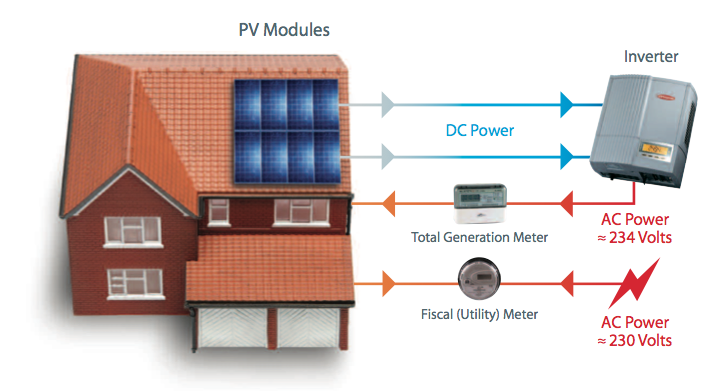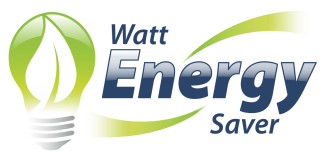
How Do Photovoltaic (PV) Cells Work?
PV cells are panels you can attach to your roof or walls. Each cell is made from one or two layers of semiconducting material, usually silicon. When light shines on the cell it creates an electric field across the layers. The stronger the sunshine, the more electricity is produced.
PV cells come in a variety of shapes and colours, from grey “solar tiles” that look like roof tiles to panels and transparent cells that you can use on conservatories and glass. The strength of a PV cell is measured in kilowatt peak (kWp). That’s the amount of energy the cell generates in full sunlight.
Solar panels produce DC or ‘direct current’ electricity. To be able to use this in our property it must be converted to Alternating Current (AC) and synchronised with your grid electricity supply using an inverter.
The inverter constantly monitors the electricity imported from the national grid and then modifies the DC produced by the solar panels to match the usable electricity perfectly. From the inverter we run a cable to your consumer unit (Fuse box). This enables you to use the electricity you generate and automatically sell back to the grid what you don’t!
Watt Energy Saver can give advice on how to best make use of the electricity you generate, feel free to ask one of our engineers!
During our site survey we can agree location of equipment routes which cables can (and cannot !) take. We treat ever property we enter as our own to ensure the least amount of disruption is caused.
How do clouds affect generation?
Solar PV operates on light from the sun, rather than heat. This means that whenever there is light available, the system will be generating electricity; even if the day seems cool and overcast. Although the system will therefore produce electricity all year round, its output will fluctuate seasonally, with the most electricity being produced in the bright summer months when there is a greater amount of direct sunlight available.
How do I know if a Solar PV system is suitable for my property?
Solar PV panels are suitable for both urban and rural locations and are adaptable to almost any building which has sufficient exposure to light. Typically, solar PV panels are mounted on a pitched roof; however they can also be mounted on a flat roof or on the ground
The Export Tariff:
You earn an additional tariff for every kilowatt hour of electricity you generate and sell back to the grid. Most electricity suppliers are not metering the export of electricity. They are paying the export rate on half the total generated. For this reason we have calculated the returns based on you using half the energy generated with the other half exported.
Electricity Bill Reduction:
This saving comes from using the energy generated by your solar PV in your own property which you would have otherwise had to purchase from your supplier.
How Long Does It Take To Repay The Embedded Carbon?
The time period for a photovoltaic cell to generate enough electricity to pay back the carbon (energy) required to make it is generally shorter than the economic payback, and is nearly always under four years.
Do I Need To Inform The National Grid?
As part of our design works we can notify the National Grid on your behalf. Read our section on G99 here.....
PV cells are panels you can attach to your roof or walls. Each cell is made from one or two layers of semiconducting material, usually silicon. When light shines on the cell it creates an electric field across the layers. The stronger the sunshine, the more electricity is produced.
PV cells come in a variety of shapes and colours, from grey “solar tiles” that look like roof tiles to panels and transparent cells that you can use on conservatories and glass. The strength of a PV cell is measured in kilowatt peak (kWp). That’s the amount of energy the cell generates in full sunlight.
Solar panels produce DC or ‘direct current’ electricity. To be able to use this in our property it must be converted to Alternating Current (AC) and synchronised with your grid electricity supply using an inverter.
The inverter constantly monitors the electricity imported from the national grid and then modifies the DC produced by the solar panels to match the usable electricity perfectly. From the inverter we run a cable to your consumer unit (Fuse box). This enables you to use the electricity you generate and automatically sell back to the grid what you don’t!
Watt Energy Saver can give advice on how to best make use of the electricity you generate, feel free to ask one of our engineers!
During our site survey we can agree location of equipment routes which cables can (and cannot !) take. We treat ever property we enter as our own to ensure the least amount of disruption is caused.
How do clouds affect generation?
Solar PV operates on light from the sun, rather than heat. This means that whenever there is light available, the system will be generating electricity; even if the day seems cool and overcast. Although the system will therefore produce electricity all year round, its output will fluctuate seasonally, with the most electricity being produced in the bright summer months when there is a greater amount of direct sunlight available.
How do I know if a Solar PV system is suitable for my property?
Solar PV panels are suitable for both urban and rural locations and are adaptable to almost any building which has sufficient exposure to light. Typically, solar PV panels are mounted on a pitched roof; however they can also be mounted on a flat roof or on the ground
The Export Tariff:
You earn an additional tariff for every kilowatt hour of electricity you generate and sell back to the grid. Most electricity suppliers are not metering the export of electricity. They are paying the export rate on half the total generated. For this reason we have calculated the returns based on you using half the energy generated with the other half exported.
Electricity Bill Reduction:
This saving comes from using the energy generated by your solar PV in your own property which you would have otherwise had to purchase from your supplier.
How Long Does It Take To Repay The Embedded Carbon?
The time period for a photovoltaic cell to generate enough electricity to pay back the carbon (energy) required to make it is generally shorter than the economic payback, and is nearly always under four years.
Do I Need To Inform The National Grid?
As part of our design works we can notify the National Grid on your behalf. Read our section on G99 here.....

